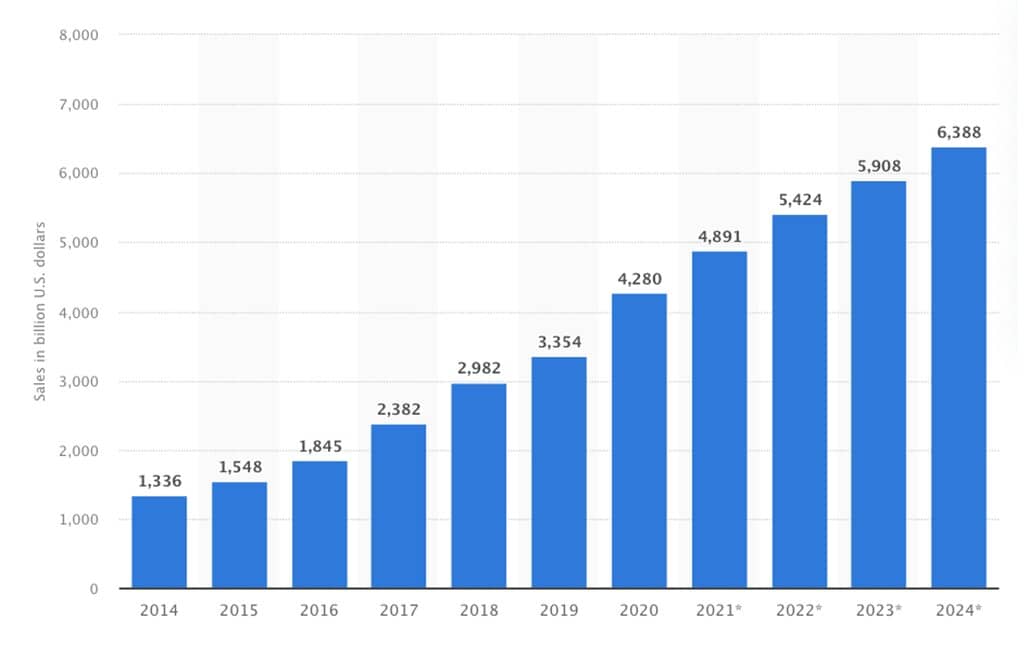
Trends: The evolution of the digital buyer’s profile in 2021
It’s worth taking a second to get perspective on how the digital buyer’s profile has evolved in the past year. It’s been 12 months where already notable trends were consolidated and others that weren’t as anticipated have emerged.
The ever-present pandemic continues to act, to a certain extent, as a catalyst for the digital channel and has had a critical impact on the buyers’ needs, motivation and deterrents.
The new digital buyer
Let’s take a look at some of the trends that show the evolution of the digital buyer profile in 2021 and the first months of 2022.
Sustained e-commerce growth
The first conclusion is that there are more digital buyers and they convert better. It’s true that we’re coming from 2020, the year that even the most reluctant Internet shopper had to approach the channel for the simple question of availability (or health safety).
As such, growth data compared to the previous period are somewhat lower but still impressive. As we can see in the Statista report, the trend towards digital shopping continues, thanks to past shoppers buying more and those who joined in 2020 stuck around, to the detriment of retail.
Foresight ov er immediacy
er immediacy
We aren’t saying that short-term delivery is no longer valued. This is something of a market standard and it’s absolutely normal to receive orders within 24 hours or even on the same day.
But if immediacy is still important, what’s changed for the consumer? The answer is simple: the market.
COVID-19 is obviously relevant here. Production in many critical sectors stopped for months due to a lack of raw materials that couldn’t be processed, but the activity that resumed almost immediately throughout the world caused unfeasible peaks in demand and transport… chaos.
This has led to what we call the container crisis, which is nothing more than problems in the global supply chain that affect the price of shipping the containers themselves.
Digital shoppers have been no strangers to this and have seen some shortages and longer delivery times. Therefore, we’ve had to foresee their orders to receive them on time (which has affected critical periods like Black Friday and Christmas).
Growth of the DTC Business Model
This is something we’ve seen grow in 2021 and will be a trend in the coming months due, in part, to the exportation problems we’ve just discussed.
More and more brands are moving to a direct to consumer sales model, meaning proximity sales that aren’t only more efficient logistically and provide greater benefits to the seller, they also cut out intermediaries. Furthermore, they mesh with the next trend we’re going to talk about: sustainability.
These types of brands usually have a proximity component, meaning transportation has less impact, thus reducing their carbon footprint.
Ethical and sustainable consumers
If the consumer cares about the products’ origin, the traceability of the raw materials and the processes involved, businesses that are ethical and committed to sustainability have a marketing argument and an added edge.
Concern for the environment is increasing and we need to convey to customers that we’re part of the solution or, at least that we aren’t part of the problem.
Multi-channel customer service
In any time of uncertainty, like what we’re going through now, customer service is of paramount importance. It acts as the first line of defense against reputation crises caused by service problems but can also be an important added value in the face of commercial activity dispelling doubts in real-time.
To do this, we need to have strong customer service capable of resolving those doubts with the most resources: livechats, chatbots, messaging tools, telephone, email, etc. The more transparent and accessible we are, the better the shopping experience will be.
Marketing in other channels
Clearly Google is still a vital source of traffic and social networks also generate a significant amount but something is changing with the players involved.
Facebook, probably affected by so many privacy-related scandals, is showing some signs of weakness. Ironically, Instagram is still on top, but it’s beginning to see rivals creep up that weren’t there even just a couple of years ago.
There are basically two platforms that stand out for growth and influence: TikTok and Twitch. The former exploded in 2020, becoming the most installed app in the world during confinement. In 2021, it’s matured a bit and the advertising platform has become increasingly efficient.
As for Twitch, little more needs to be said about a video streaming network capable of overshadowing many media outlets and even causing some inconvenience for the quintessential video platform: YouTube.
Influencer marketing is moving from “classic” platforms to these alternatives, or at least we can say that influencers and content creators have added these channels to their strategies.
Products as services
Another trend on the rise is turning products into services. Buyers increasingly value the experience more than the physical object, meaning it’s especially appealing for them to subscribe and pay per use.
The best examples are video on demand platforms that have taken a large part of the cinema market to in-home formats. Something similar is happening with music or even with books and services like Kindle Unlimited.
Other sectors that are going the same way are the automotive and technology sectors (there are already platforms where we can rent computers and other devices for a monthly fee).
These are some of the e-commerce trends and patterns we’ve observed in the market in 2021. Which ones would you highlight?












